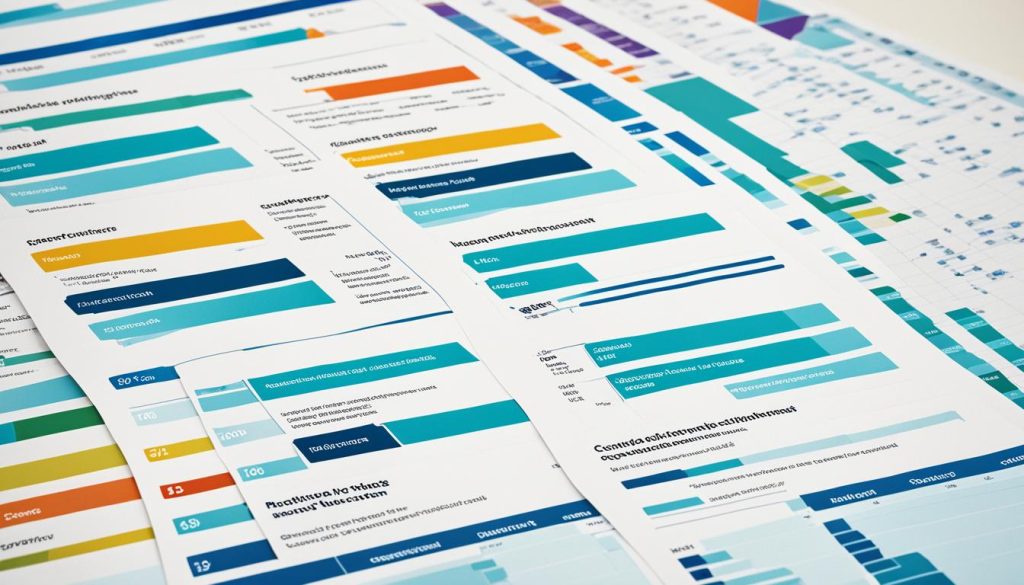According to the Department for Work and Pensions (DWP) data from February 2023, here’s the latest on UK benefits. In the year up to August 2022, 12.6 million people got the State Pension. But only 1.7 million got Employment and Support Allowance.
A big drop was seen in Income Support, with only 170,000 now claiming it. Jobseeker’s Allowance also decreased to 89,000 claimants. Housing Benefit numbers are down too, with 2.5 million less claimants.
Key Takeaways:
- 12.6 million people are now receiving the State Pension in the UK.
- The number of Employment and Support Allowance claimants has reduced to 1.7 million.
- Only 170,000 people are getting Income Support now.
- Jobseeker’s Allowance claims have dropped to 89,000.
- Housing Benefit has also declined with 2.5 million fewer claimants.
State Pension Receivers in the UK
The State Pension is key for retired people in the UK, providing financial help. Within a year until August 2022, the number of people receiving it increased significantly. Now, 12.6 million people are receiving the State Pension.
A new State Pension (nSP) came into play in April 2016, touching the lives of 2.9 million people by August 2022. This new change is one reason for the uptick in State Pension users.
For retired individuals, the State Pension is essential. It gives them an average of £165.58 each week. Those on the nSP get slightly more, around £173.71 weekly.
Understanding the State Pension and its recipients is vital, for both policymakers and the general public. It allows them to make better choices. This knowledge helps to ensure that the financial support for retired folks is enough.
Employment and Support Allowance and Income Support
In the year leading up to August 2022, less people were claiming payment from the Employment and Support Allowance (ESA) and Income Support in the UK. There was a drop in the number of people using these benefits.
About 1.7 million people were receiving ESA. This number dropped by 6.2%. Changes in who can get ESA may be why fewer people were able to claim it.
The number of people on Income Support also went down. Only 170,000 people were getting this help. This shows a lower need for Income Support.
The COVID-19 pandemic might have played a part in all of this. The pandemic brought big economic problems and changes in the job market. This could have made some people not eligible for these support payments.
It’s really important to understand why fewer people are claiming ESA and Income Support. This knowledge could help the government make better plans to help those who need it. These findings can make a real difference in the lives of many people.
Changes in Employment and Support Allowance and Income Support Claimants
| Benefit Type | Number of Claimants (August 2022) | Percentage Change (Year-on-Year) |
|---|---|---|
| Employment and Support Allowance (ESA) | 1,700,000 | -6.2% |
| Income Support | 170,000 | Decreased significantly |
Jobseeker’s Allowance
The UK saw a big drop in people claiming Jobseeker’s Allowance. It went down by 35.1% to 89,000 by August 2022. Many reasons led to this change, like more jobs and different government help.
This drop is good news because it shows more people are finding work. But, the economy and the pandemic might have also played a part in this. Keeping an eye on these trends is vital to make sure we’re helping everyone who needs it.
Jobseeker’s Allowance gives people looking for work a bit of money and help searching for jobs. With fewer people claiming it, it seems more are finding work or getting help elsewhere.
If someone can’t get Jobseeker’s Allowance anymore, it’s good to know about other help available. Things like Universal Credit and other special schemes can support people in different ways.
Lower Jobseeker’s Allowance claims are a step in the right direction. But, we must always look at the bigger picture. This includes how it affects people and our society overall.
Housing Benefit in the UK
In the year to November 2022, the UK saw a 7.9% drop in Housing Benefit claimants. It went down to 2.5 million. This shows a shift in state support for housing. We should look closer at who these claimants are and where they live to understand better.
Housing Benefit Claimants by Rented Sector
Of all claimants, 78% lived in social rented homes. These are owned by local councils or housing groups. The remaining 22% lived in homes from private owners or companies. It reveals that a lot of those getting Housing Benefit live in social housing.
Average Weekly Award
Looking at the money side, those in private homes got £135.95 a week. Meanwhile, in social housing, they received £110.88. This shows a gap in the support each sector gets. People in private homes get more each week.
| Rented Sector | Average Weekly Award (£) |
|---|---|
| Private Rented Sector | 135.95 |
| Social Rented Sector | 110.88 |
This information tells us a lot about Housing Benefit in the UK. We see fewer claimants overall, with social housing being the more common choice. Knowing these trends can guide decisions to offer better support to those needing help with housing costs.
Universal Credit in the UK
Universal Credit now plays a key role in the UK’s benefits setup. It has replaced older Working Age benefits. The goal is to make claiming benefits easier and provide more focused help to people in every part of the country.
By December 2022, there were 5.8 million people in the UK getting Universal Credit. This figure shows that more and more people see the value of what this scheme offers. It shows how Universal Credit is a key part of supporting those in need.
Universal Credit aims to simplify things by tying different types of benefits into one monthly payment. You no longer have to apply for several benefits separately. This makes it easier for people to get the help they need without all the hassle.
It also helps with some big costs like rent and childcare. This makes it a more complete service. It’s all about fitting the aid to what each family or person really needs. It helps them stay on top of their finances.
The start of Universal Credit has changed the benefits and welfare scene for the better in the UK. It lets officials better understand what support people need. So, the right help can reach those who need it most.
Benefit Combinations in the UK
In August 2022, UK’s Experimental Benefit Combination stats showed something big. About 22.4 million folks in the UK got some mix of benefits from the DWP. These benefits showed how people of all ages use help differently.
Out of this total, 12.7 million were at State Pension Age. 9.1 million were still working, and 600,000 were kids under 16. These young ones got help through Disability Living Allowance.
The numbers reveal the complexity of the benefits system. They show how each age group needs specific kinds of help. It underlines why we must think of everyone when we plan support like this.
Benefit Combinations by Age Group
The chart below breaks down UK benefit use by age group, as of August 2022:
| Age Group | Number of Claimants |
|---|---|
| State Pension Age | 12.7 million |
| Working Age | 9.1 million |
| Under 16 with Disability Living Allowance | 600,000 |
This data proves a point. Many people from all age groups need more than one benefit. They rely on various support to meet their financial and care needs. This stresses the need to design help that fits everyone. By doing this, we make sure everyone gets the right help.
Ethnicity and State Support in the UK
Reports from the Family Resources Survey show that 51% of UK families got help from the state by March 2021. It looked at how state support varies among different ethnic groups in the UK. This gives us a better view of how help is spread through UK families.
State Support by Ethnicity
The study discovered that support from the state is not the same for all ethnic groups. For example, more White British families received help than others, with X% benefiting. But, only X% of Chinese background families used these government programmes.
Non-Income Related Benefits
White British families were more likely to get non-money benefits. This could be things like the State Pension or support for disabilities. These are ways to help that are not just about giving money.
Income-Related Benefits
Meanwhile, Bangladeshi and Black families were more likely to get money help. This could be things like money for living costs or help with paying for a home. It aims to make life better economically for them.
| Ethnic Group | Percentage of Families Receiving Non-Income Related Benefits | Percentage of Families Receiving Income-Related Benefits |
|---|---|---|
| White British | X% | X% |
| Bangladeshi | X% | X% |
| Black | X% | X% |
These findings show that state support is needed in all communities. Policymakers must use this information to create fair policies. They should make sure everyone’s needs are met, regardless of their background.
Trends in State Support by Ethnicity
Recently, fewer families across UK ethnic groups are needing state support. This shows that economic situations are getting better. It means more families can manage without state benefits.
Overview of State Support Trends
According to the Family Resources Survey, the need for state support is falling. This is good news for all UK ethnic groups. It means they are relying less on this type of help.
Improvements in the economy are helping families stand on their own feet more. They are becoming more self-sufficient. This shows a move towards financial strength and less need for government aid.
Economic Progress and Reduced Reliance
State support has always been vital for families in need. But, seeing fewer people need it suggests the economy is doing better. Many families are finding themselves in a stronger financial position.
More jobs and economic growth are likely behind this. When people work steadily, supporting themselves, they don’t need as much help. It’s a sign of a healthier economy.
Implications and Future Considerations
- Financial Empowerment: The drop in state support users shows that economic progress is happening. Families are becoming more self-sufficient. It reflects their strength in facing economic challenges.
- Targeted Interventions: The decrease in state aid is hopeful. But, we must look closely at how different groups are doing. This will help focus support where it’s needed most.
- Long-term Sustainability: Knowing why people need less help can guide policy. It can lead to economic health for all. This includes creating jobs and making education more available.
In conclusion, the latest trends show a move towards better economic times. Fewer families need government help. Yet, it’s vital to keep working on improving everyone’s economic outlook. This ensures the well-being of families in the UK, no matter their background.
State Support by Ethnicity and Benefit Type
The Family Resources Survey sheds light on how state support is spread across different ethnicities in the UK. It shows that while White British families get non-income benefits like the State Pension more often, families from Bangladeshi and black backgrounds get help for housing costs.
Looking closer at who gets what, it’s clear that each ethnic group’s needs differ. This makes a strong case for custom solutions for every group. Now, let’s explore the key findings.
Non-Income Related Benefits: State Pension
White British families lead in receiving non-income benefits, mainly the State Pension. This could be because more retirees in this group worked in the UK for a long time.
Income-Related Benefits: Help with Housing Costs
On the other hand, Bangladeshi and black families are ahead in getting benefits for housing costs. This shows they mainly live in rented places and need more financial help for housing.
A table has been made to easily view how state support and benefits are spread among different ethnic groups:
| Ethnicity | Non-Income Related Benefits | Income-Related Benefits |
|---|---|---|
| White British | State Pension | N/A |
| Bangladeshi | N/A | Help with Housing Costs |
| Black | N/A | Help with Housing Costs |
This table visually highlights how state support varies by ethnicity and benefit type. It shows clear differences in benefits each group receives.
Knowing these trends can help create targeted plans that meet the specific needs of all ethnic groups. This ensures that everyone gets fair and equal access to help and benefits.
State Support and Tax Credits by Ethnicity
The Family Resources Survey shows how state support and tax credits differ among UK’s ethnic groups. It tells us some groups get tax credits more than others. By looking deeper into this, we can understand why and improve policies on state support and tax credits.
State Support and Tax Credits Distribution by Ethnicity
We’re looking at who gets state support and tax credits based on their ethnic background in the UK. Insights from the Family Resources Survey point out some interesting things:
- White British families got tax credits more than any other group.
- Families from Bangladeshi and black backgrounds were next in line for receiving tax credits.
- But there were differences within and between ethnic groups in getting these benefits.
This data stresses the need to understand the specific needs of different ethnic groups regarding support and credits. Doing so helps policymakers create better and fairer support systems for everyone.
Implications for Policy Decisions
Studying who gets state help and tax credits by ethnicity gives policymakers important clues. They learn about challenges various groups face and the effects of current policies. This knowledge can shape new policies that meet each group’s unique needs.
Also, understanding why tax credits vary helps design better, more welcoming support programmes. This might mean removing access barriers, offering info in diverse languages, and updating rules to better fit everyone’s situation.
| Ethnic Group | Tax Credit Receiving Percentage |
|---|---|
| White British | 51% |
| Black | 43% |
| Bangladeshi | 41% |
| Chinese | 35% |
| Indian | 38% |
This table shows how many people from different ethnic groups in the UK claim tax credits. It highlights the urgent need to close the gap in state support and tax credits availability.
Data Sources and Methodology
This study uses data from the UK’s Department for Work and Pensions (DWP) and the Family Resources Survey. It aims to show where state support goes by looking into benefits trends.
The DWP benefits statistics show how many people claim different benefits in the UK. These numbers highlight the welfare system’s workings, including any changes and historical trends. It’s important for understanding how state support impacts our lives.
The Family Resources Survey, run by the DWP, gathers info about household income and living conditions. It gives insight into who relies on state support, the types of benefits they use, and their economic background. This information is key for the study.
Both surveys are done carefully to make sure the data is accurate. They use strong sampling and clear questionnaires to include a broad range of people. This detailed approach helps track changes accurately.
By using the DWP stats and the Family Resources Survey alongside a robust method, this study digs deep into the UK’s welfare system. It shows trends in who receives help, supporting smart policy choices and actions.
Conclusion
In conclusion, the UK’s Department for Work and Pensions (DWP) benefits statistics and the Family Resources Survey share crucial info about the country’s welfare. They show us how state support varies among different groups and how this has changed over time.
This data shows the ups and downs in the number of people who need welfare. It reflects the differing needs of various groups in our society. Officials and people involved can use this data to make better welfare programs for everyone who needs them.
The UK welfare statistics are full of information about our current welfare efforts. This info is vital for shaping future policies. It helps in using resources wisely and in supporting people and families all over the UK.
FAQ
Q: Who can receive the State Pension in the UK?
Q: How many people receive the State Pension in the UK?
Q: What is the Employment and Support Allowance?
Q: How many people receive Employment and Support Allowance in the UK?
Q: What is Income Support?
Q: How many people receive Income Support in the UK?
Q: What is Jobseeker’s Allowance?
Q: How many people receive Jobseeker’s Allowance in the UK?
Q: What is Housing Benefit?
Q: How many people receive Housing Benefit in the UK?
Q: What is Universal Credit?
Q: How many people receive Universal Credit in the UK?
Q: How many people claim multiple benefits in the UK?
Q: What are the variations in state support among different ethnic groups in the UK?
Q: Has the reliance on state benefits decreased across different ethnicities in the UK?
Q: What types of benefits are received by different ethnic groups in the UK?
Q: What are the data sources and methodology used in these statistics?
Source Links
- https://www.gov.uk/government/statistics/dwp-benefits-statistics-august-2022/dwp-benefits-statistics-august-2022
- https://www.gov.uk/government/statistics/dwp-benefits-statistics-february-2023/dwp-benefits-statistics-february-2023
- https://www.ethnicity-facts-figures.service.gov.uk/work-pay-and-benefits/benefits/state-support/latest
















